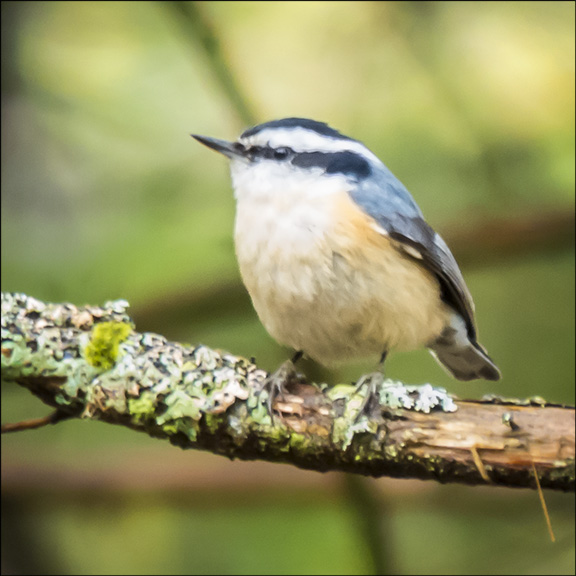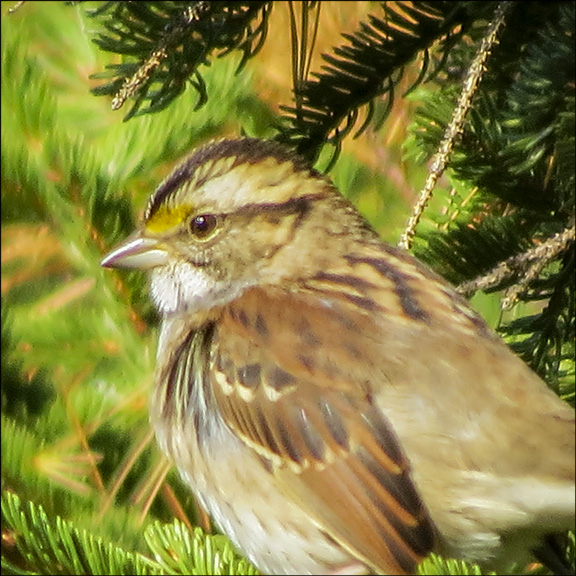Trees of the Adirondacks:
Red Spruce (Picea rubens)
 Trees of the Adirondacks: Red Spruce needles are short, four-sided, and unfriendly to the touch. Red Spruce on the Barnum Brook Trail (28 July 2012)
Trees of the Adirondacks: Red Spruce needles are short, four-sided, and unfriendly to the touch. Red Spruce on the Barnum Brook Trail (28 July 2012)
| This page is no longer being updated. For an updated and expanded version of this material, see: Red Spruce (Picea rubens). |
The Red Spruce (Picea rubens) is a medium-sized evergreen conifer that grows in cool, boreal forests of the northeast, including the Adirondack Mountains. Red spruce is the provincial tree of Nova Scotia. This species is a member of the pine family. This tree is also known as Yellow Spruce, West Virginia Spruce, Eastern Spruce, and He Balsam. (The latter name is to distinguish the Red Spruce from the southern-growing Fraser Fir, which is known as "She Balsam" because of the resin-filled blisters on the tree's trunk. Red Spruce lacks the distinctive blisters.)
This species is vulnerable to damage from acid rain. Although acid rain – the result of pollutants in the emissions from power plants and other industrial facilities – has stressed Adirondack forests as a whole, two species have experienced particularly heavy losses: Red Spruce and Sugar Maple. In regard to the Red Spruce, acid rain leaches calcium out of the needles and reduces the needles' ability to tolerate freezing temperatures. Acid rain also interferes with the tree's ability to acquire nutrients from the thin Adirondack soils. This combination of reduced freeze tolerance and nutrient stress, which makes the trees more susceptible to insects and disease, is thought to be responsible for the loss of roughly half of the high-altitude spruce forests in the Adirondacks.

Identification of the Red Spruce: Red Spruce trees have four-sided, short,yellowish green needles on woody pegs. The cones, which fall soon after maturity, are around 1.5 inches long. They hang pendantly and are reddish-brown and woody. The slender new twigs have a reddish coat of down through the first year. The bark of Red Spruce trees is gray-brown to reddish brown.
This species flowers in May. The pendant male flowers are bright red, while the female flowers are erect and bright green tinged with purple. In growth habit, this tree is rather open-branched, with up-curved tips.
Keys to identifying the Red Spruce and differentiating it from other coniferous trees include its needles, bark, growth habit, and habitat.
- Red Spruce trees are easily distinguished from Eastern White Pine, since the latter tree has much longer needles in bundles, while the needles of the Red Spruce grow individually on the twig.
- Red Spruce needles can also be differentiated from those of the Balsam Fir, which are also short. Balsam Fir needles, particularly those on lower branches, appear to be two-ranked. The needles appear to occupy a single horizontal plane and are soft and friendly to the touch. Red Spruce needles, by contrast, are sharp-pointed and prickly, growing all around the twig. Moreover, Red Spruce needles are four sided, in contrast to the flat needles of the Balsam Fir. Finally, the cones of Red Spruce are orange-brown, contrasting with the bluish brown cones of the Balsam Fir. The bark is another key identifier, since Red Spruce bark lacks the resin blisters of the Balsam Fir.
- The needle arrangement of Red Spruce also differentiates it from that of Eastern Hemlock, which appear to occupy a single horizontal plane.
- The arrangement of Red Spruce needles also contrasts with that of Tamaracks. Tamarack needles are relatively short, like those of the Red Spruce, but are produced in clusters of ten to twenty, as opposed to the single needles of the Red Spruce. Moreover, Tamaracks thrive in much wetter soil than Red Spruce.
- Red Spruce can be distinguished from Black Spruce by its growth habit and habitat. The silhouette of a Red Spruce tree is pyramidal. By contrast, Black Spruce trees are slender, with short branches. Moreover, Black Spruce trees thrive in the middle of bogs, where Red Spruce does not grow.
Differentiating Red Spruce from White Spruce is somewhat trickier.
- The needles of Red Spruce are yellowish green, in contrast to the bluish green needles of the White Spruce. Moreover, the needles of the Red Spruce exude a fruity scent similar to that of orange rind when crushed. By contrast, the needles of the White Spruce (sometimes known as the Cat Spruce or Skunk Spruce) exude a pungent odor evocative of cat urine or skunk when crushed.
- The cones of the Red Spruce are somewhat smaller than those of White Spruce.
- Red Spruce tends to be more open-branched than White Spruce.
Uses of the Red Spruce: Red Spruce is one of the most important forest trees in the northeast. The wood is light, soft, and faintly tinged with red. This tree is used primarily for lumber and pulpwood. It is also used for construction lumber, plywood, boxes, sash frames, and musical stringed instruments. It is the preferred wood for piano sounding boards, guitars, mandolins, organ pipes, and violin bellies. It is also used as a Christmas tree. One unique use of red spruce was spruce gum.
This plant was used medicinally by several North American Indian tribes as a remedy for throat ailments, lung trouble, and measles; the needles were also used to make a beverage and the gum to make pitch. Native people also used the peeled roots of Red Spruce for lacing. Early settlers used the fresh green buds to flavor beers.

Wildlife Value of the Red Spruce: Red Spruce provides food and cover for various mammals and birds. Habitats which include Red Spruce are particularly important as winter cover for White-tailed Deer and, to a certain extent, Moose. Red Squirrels eat buds and seeds. Mice and voles consume and store significant amounts of spruce seeds. Porcupines feed on the bark in winter.
Red Spruce provides food and nest sites for a number of birds. The Spruce Grouse feeds on the buds and foliage. Red spruce seeds reportedly make up 25 to 50 percent of the diet of White-winged Crossbills. Black-throated Green Warblers and Pileated Woodpeckers also forage on Red Spruce trees.
The Red Spruce is a common tree species in the breeding habitat of a wide variety of birds, including:

Distribution of the Red Spruce The range of this species is much more limited than those of the Black Spruce, Tamarack, or Balsam Fir. The range of the Red Spruce extends only from the Maritime Provinces of Canada west to Maine, southern Quebec, and southeastern Ontario, and south into central New York, eastern Pennsylvania, northern New Jersey, and Massachusetts. There are also stands of Red Spruce in parts of the Appalachian Mountains. In New York State, Red Spruce trees are found primarily in the north and eastern parts of the state, including the Adirondack Mountains and the Catskills.
Red Spruce trees grow in climates with cool, moist summers and cold winters. Most of the soils on which Red Spruce occurs are developed from glacial deposits. Red Spruce trees can usually be found in mixed conifer forests with Eastern Hemlock and Balsam Fir. Red Spruce trees also grow in mixed hardwood/conifer forests with aspens, birches, maples, and beech species.
Red Spruce at the Paul Smiths VIC: Red Spruce trees, in contrast to Black Spruce and Tamaracks, do not grow in the middle of bogs or marshes. However, they do tolerate somewhat moist soils and can often be found in mixed stands, with other conifers and hardwoods. Look for Red Spruce trees along many of the trails at the VIC, growing near Eastern White Pine, Eastern Hemlock, Red Maple, Hobblebush, and Balsam Fir. A number of herbaceous plants flourish near this tree, including Clintonia, Common Woodsorrel, and Wild Sarsaparilla.
The most convenient place to observe the Red Spruce and compare it with other conifers at the VIC is on the Barnum Brook Trail. This species is one of the eleven tree species marked with signage along this trail. The identified Red Spruce tree is about a quarter of a mile from the entrance gazebo. If you take the left hand fork and walk the trail in a clockwise direction, the tree is just past the bench, on the right hand side of the trail, just before the Eastern White Pine.
References
- United States Department of Agriculture. Forest Service. Silvics of North America. Red Spruce. Retrieved 13 March 2015.
- United States Department of Agriculture. Red Spruce Plant Guide. Retrieved 13 March 2015.
- Lady Bird Johnson Wildflower Center. Native Plant Database. Retrieved 13 March 2015.
- Online Encyclopedia of Life. Picea rubens. Retrieved 13 March 2015.
- New York Flora Association. New York Flora Atlas. Retrieved 13 March 2015.
- University of Michigan. Native American Ethnobotany. A Database of Foods, Drugs, Dyes and Fibers of Native American Peoples, Derived from Plants. Retrieved 13 March 2015.
- Plants for a Future. Database. Retrieved 13 March 2015.
- The Birds of North America. Subscription Web Site. Cape May Warbler, Blackpoll Warbler, Golden-crowned Kinglet, Spruce Grouse, Northern Saw-whet Owl, Yellow-bellied Flycatcher, Black-throated Green Warbler, Mourning Warbler, Canada Warbler, Olive-sided Flycatcher, Yellow-rumped Warbler, White-winged Crossbill, Evening Grosbeak, Pileated Woodpecker, White-throated Sparrow, Red-breasted Nuthatch, Retrieved 13 March 2015.
- Trees of the Northern Forest Trail Walk
- New York State Department of Environmental Conservation. Winter Deer Foods. Retrieved 13 March 2015.
- Jack Saul, "Spruce up Your ID Skills," Northern Woodlands, 24 December 2012. Retrieved 14 March 2015.
- Paul Smith’s College VIC. Barnum Brook Tree Game.
- George A. Petrides. A Field Guide to Eastern Trees (Boston: Houghton Mifflin Company, 1998), pp. 38-39, 175.
- George A. Petrides. A Field Guide to Trees and Shrubs (Boston: Houghton Mifflin Company, 1958,1972), pp. 3, 23-24, 40-41.
- Gil Nelson, Christopher J. Earle, and Richard Spellenberg. Trees of Eastern North America (Princeton : Princeton University Press), pp. 60-61.
- C. Frank Brockman. Trees of North America (New York: St. Martin's Press), pp. 38-39.
- Keith Rushforth and Charles Hollis. Field Guide to the Trees of North America (Washington, D.C., National Geographic, 2006), p. 68.
- National Audubon Society. Field Guide to North American Trees. Eastern Region. (New York: Alfred A. Knopf, 1980), Plates 25, 478, pp. 285.
- John Kricher. A Field Guide to Eastern Forests. North America (Boston: Houghton Mifflin, 1998), pp. 62-67.
- Alexander C. Martin, Herbert S. Zim, and Arnold L. Nelson. A Guide to Wildlife Food Habits (New York: Dover Publications, 1951), pp. 237, 290.
- Bruce Kershner, et al. National Wildlife Federation Field Guide to Trees of North America (New York: Sterling Publishing Co., 2008), pp. 100-101.
- David Allen Sibley. The Sibley Guide to Trees (New York: Alfred A. Knopf, 2009), p. 47.
- Douglass H. Morse, "Habitat Selection in North American Parulid Warblers," in Martin L. Cody (ed.), Habitat Selection in Birds (Orlando, Florida: Academic Press, Inc., 1985), pp. 131-157.
- Douglass H. Morse, "Variables affecting the density and territory size of breeding spruce-woods warblers," Ecology (1976) 57: pp. 290-301.
- James M. Ryan. Adirondack Wildlife: A Field Guide (Lebanon, New Hampshire, 2008), pp. 37-41.
